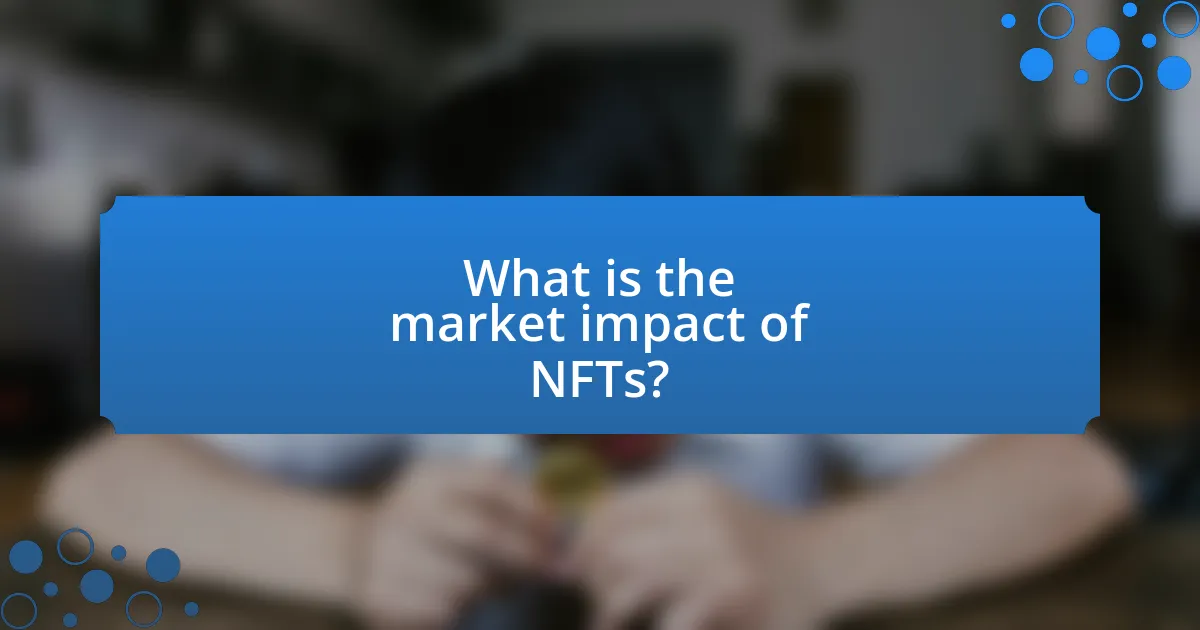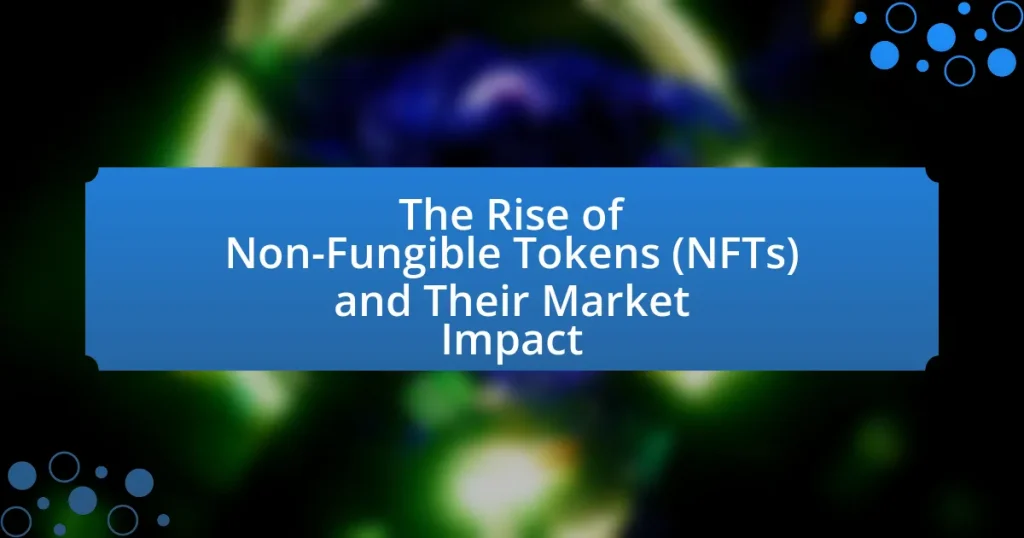Non-Fungible Tokens (NFTs) are unique digital assets that signify ownership of specific items or content on a blockchain, distinguishing them from traditional cryptocurrencies. This article explores the characteristics that make NFTs unique, their primary use cases in art, gaming, and collectibles, and the factors contributing to their recent popularity. It also examines the market impact of NFTs, including their role in transforming digital ownership and creating new economic opportunities, while addressing challenges such as market volatility and environmental concerns. Additionally, the article discusses the future of NFTs, potential technological advancements, and best practices for investors engaging with this evolving market.
-1.webp)
What are Non-Fungible Tokens (NFTs)?
Non-Fungible Tokens (NFTs) are unique digital assets that represent ownership of a specific item or piece of content on a blockchain. Unlike cryptocurrencies such as Bitcoin or Ethereum, which are fungible and can be exchanged for one another, NFTs are distinct and cannot be replaced with something else of equal value. This uniqueness is often verified through smart contracts on blockchain platforms like Ethereum, ensuring that each NFT has a specific identifier and metadata that distinguishes it from other tokens. The rise of NFTs has significantly impacted various markets, particularly in art, gaming, and collectibles, with sales reaching billions of dollars in recent years, highlighting their growing importance in the digital economy.
How do NFTs differ from traditional cryptocurrencies?
NFTs, or Non-Fungible Tokens, differ from traditional cryptocurrencies primarily in their fungibility; NFTs are unique digital assets that represent ownership of a specific item or piece of content, while traditional cryptocurrencies like Bitcoin or Ethereum are fungible and can be exchanged on a one-to-one basis. This uniqueness of NFTs is established through blockchain technology, which verifies the ownership and provenance of each token, making them suitable for representing art, collectibles, and other distinct items. In contrast, traditional cryptocurrencies serve as a medium of exchange or store of value, where each unit is identical and interchangeable with another unit of the same cryptocurrency.
What characteristics make NFTs unique?
NFTs are unique due to their non-fungibility, verifiable ownership, and scarcity. Non-fungibility means each NFT represents a distinct asset that cannot be exchanged on a one-to-one basis with another NFT, unlike cryptocurrencies such as Bitcoin. Verifiable ownership is ensured through blockchain technology, which provides a transparent and immutable record of ownership and transaction history. Scarcity is created by limiting the number of copies or editions of a digital asset, making certain NFTs rare and potentially more valuable. These characteristics differentiate NFTs from traditional digital assets and contribute to their growing market impact.
Why are NFTs considered non-fungible?
NFTs are considered non-fungible because each token represents a unique digital asset that cannot be exchanged on a one-to-one basis with another token. Unlike fungible assets, such as cryptocurrencies or traditional currencies, which are identical and interchangeable, NFTs have distinct properties, ownership, and metadata that differentiate them from one another. For example, an NFT representing a digital artwork has specific attributes, such as the creator’s identity and the artwork’s history, making it unique and irreplaceable. This uniqueness is enforced through blockchain technology, which securely records ownership and provenance, ensuring that each NFT is one-of-a-kind.
What are the primary use cases for NFTs?
The primary use cases for NFTs include digital art, collectibles, gaming, and tokenization of real-world assets. Digital art has gained significant traction, with platforms like OpenSea facilitating sales of unique artworks, often fetching millions at auctions. Collectibles, such as NBA Top Shot, allow fans to own officially licensed moments in sports, creating a new market for memorabilia. In gaming, NFTs enable players to own in-game assets, providing true ownership and the ability to trade items across different games. Additionally, NFTs can represent ownership of real-world assets, such as real estate or luxury items, by providing a secure and verifiable digital certificate of ownership on the blockchain.
How are NFTs utilized in the art world?
NFTs are utilized in the art world primarily as a means of establishing ownership and provenance for digital artworks. By minting a digital artwork as an NFT on a blockchain, artists can create a unique, verifiable token that represents their work, allowing buyers to own a piece of digital art in a way that was not possible before. This technology enables artists to sell their work directly to collectors without intermediaries, often resulting in higher profits. Additionally, NFTs can include smart contracts that allow artists to earn royalties on future sales, ensuring they benefit from the increasing value of their work over time. The rise of platforms like OpenSea and Rarible has facilitated this process, making it easier for artists to enter the market and for collectors to purchase and trade digital art securely.
What role do NFTs play in gaming and virtual worlds?
NFTs serve as unique digital assets in gaming and virtual worlds, enabling players to own, trade, and sell in-game items and characters. This ownership is facilitated by blockchain technology, which ensures the authenticity and scarcity of these assets. For instance, games like Axie Infinity and Decentraland utilize NFTs to allow players to buy, sell, and trade virtual land and creatures, creating real economic value. According to a report by NonFungible.com, the NFT gaming market generated over $4 billion in sales in 2021, highlighting the significant financial impact of NFTs in this sector.
Why has the popularity of NFTs surged recently?
The popularity of NFTs has surged recently due to increased mainstream adoption and significant investments from high-profile brands and celebrities. This surge is evidenced by the record sales of digital art and collectibles, with notable transactions such as Beeple’s artwork selling for $69 million at Christie’s in March 2021. Additionally, platforms like OpenSea have reported exponential growth in user activity, with monthly trading volume reaching over $3 billion in August 2021. This combination of high-profile endorsements and substantial market activity has contributed to the rapid rise in interest and investment in NFTs.
What factors contributed to the rise of NFTs in 2021?
The rise of NFTs in 2021 was primarily driven by increased mainstream adoption, significant investments from high-profile individuals and companies, and the growing popularity of digital art and collectibles. Mainstream platforms like Twitter and Instagram began integrating NFT features, which expanded visibility and accessibility. High-profile sales, such as Beeple’s digital artwork selling for $69 million at Christie’s, showcased the potential value of NFTs, attracting attention from investors and collectors. Additionally, the COVID-19 pandemic accelerated digital engagement, leading to a surge in interest for virtual assets, further propelling the NFT market’s growth.
How has social media influenced NFT adoption?
Social media has significantly accelerated NFT adoption by providing platforms for creators and collectors to showcase, discuss, and trade digital assets. The viral nature of social media allows NFT projects to gain visibility quickly, as seen with platforms like Twitter and Instagram, where artists share their work and engage with potential buyers. Additionally, high-profile endorsements from celebrities on social media have driven mainstream interest, exemplified by figures like Elon Musk and Lindsay Lohan promoting their own NFTs. According to a report by NonFungible.com, social media discussions around NFTs surged by over 300% in 2021, correlating with a dramatic increase in NFT sales and market activity.

What is the market impact of NFTs?
The market impact of NFTs is significant, as they have created new revenue streams and transformed the digital asset landscape. NFTs have generated billions in sales, with the market reaching approximately $41 billion in 2021, according to a report by NonFungible.com. This surge has led to increased investment in digital art, gaming, and collectibles, driving innovation and competition among creators and platforms. Additionally, NFTs have facilitated direct transactions between artists and consumers, reducing reliance on traditional intermediaries and enabling creators to retain a larger share of profits.
How have NFTs changed the landscape of digital ownership?
NFTs have fundamentally transformed digital ownership by providing verifiable proof of authenticity and scarcity for digital assets. This shift allows creators to monetize their work directly, as NFTs enable the sale of unique digital items like art, music, and virtual real estate on blockchain platforms. According to a report by NonFungible.com, the NFT market reached a valuation of over $10 billion in 2021, illustrating the significant financial impact and growing interest in digital ownership. This change has empowered artists and content creators, allowing them to retain control over their intellectual property and engage directly with their audience, thereby redefining traditional ownership models in the digital realm.
What implications do NFTs have for copyright and intellectual property?
NFTs significantly impact copyright and intellectual property by introducing new challenges and opportunities for ownership and distribution. They allow creators to tokenize their work, providing a digital certificate of authenticity that can be bought, sold, or traded. This process can complicate traditional copyright frameworks, as ownership of an NFT does not necessarily confer copyright ownership of the underlying work. For instance, a buyer may own an NFT of a digital artwork but not the rights to reproduce or distribute that artwork unless explicitly stated. Furthermore, the decentralized nature of blockchain technology complicates enforcement of intellectual property rights, as it can be difficult to track and manage unauthorized reproductions. Legal cases, such as the lawsuit involving artist Beeple’s NFT sales, highlight these complexities, demonstrating the need for clearer regulations and guidelines in the evolving landscape of digital assets.
How do NFTs affect the traditional art market?
NFTs significantly disrupt the traditional art market by introducing a new digital ownership model that allows artists to sell their work directly to consumers without intermediaries. This shift enables artists to retain a larger share of profits and provides them with ongoing royalties through smart contracts, which traditional galleries typically do not offer. For instance, a report by Art Basel and UBS in 2021 indicated that the global NFT market reached $2.5 billion in the first quarter alone, showcasing the rapid growth and interest in digital art. Additionally, the ability to verify authenticity and provenance through blockchain technology enhances trust and transparency, which are critical in the art market. This transformation challenges established norms and encourages traditional artists to explore digital mediums, thereby expanding the overall art ecosystem.
What economic opportunities do NFTs create?
NFTs create economic opportunities by enabling new revenue streams for creators and businesses through digital ownership and scarcity. Artists, musicians, and content creators can sell unique digital assets directly to consumers, bypassing traditional intermediaries, which can lead to higher profit margins. The NFT market has seen significant growth, with sales reaching over $10 billion in the third quarter of 2021 alone, demonstrating the demand for digital collectibles and assets. Additionally, NFTs facilitate innovative business models, such as royalties on secondary sales, allowing creators to earn ongoing income as their work is resold. This shift in ownership dynamics fosters a more equitable distribution of wealth within creative industries.
How can creators monetize their work through NFTs?
Creators can monetize their work through NFTs by selling unique digital assets directly to consumers on blockchain platforms. This process allows creators to establish ownership and provenance of their work, ensuring that buyers receive a one-of-a-kind item. For instance, artists can mint their artwork as NFTs and list them on marketplaces like OpenSea or Rarible, where collectors can purchase them using cryptocurrency. Additionally, creators can earn royalties on secondary sales, meaning they receive a percentage each time their NFT is resold, which provides ongoing revenue. According to a report by NonFungible.com, the NFT market generated over $10 billion in sales in 2021, highlighting the significant financial opportunities available for creators in this space.
What new business models have emerged due to NFTs?
New business models that have emerged due to NFTs include digital art marketplaces, play-to-earn gaming, and tokenized ownership of real-world assets. Digital art marketplaces allow artists to sell unique digital creations directly to consumers, leveraging blockchain technology for provenance and ownership verification. Play-to-earn gaming enables players to earn NFTs through gameplay, creating a new revenue stream for both developers and players. Additionally, tokenized ownership allows fractional ownership of physical assets, such as real estate or collectibles, making investments more accessible. These models have gained traction as the NFT market reached a valuation of over $41 billion in 2021, demonstrating significant consumer interest and investment potential.
What challenges does the NFT market face?
The NFT market faces several significant challenges, including market volatility, regulatory uncertainty, and environmental concerns. Market volatility is evident as NFT prices can fluctuate dramatically, leading to investor hesitance; for instance, the average price of NFTs dropped by over 90% from its peak in early 2022. Regulatory uncertainty arises from the lack of clear legal frameworks governing NFTs, which can deter potential investors and creators. Additionally, environmental concerns stem from the energy-intensive processes associated with blockchain technology, particularly those using proof-of-work systems, which have been criticized for their carbon footprint. These challenges collectively hinder the growth and mainstream adoption of NFTs.
How does environmental concern impact NFT transactions?
Environmental concern significantly impacts NFT transactions by influencing buyer behavior and market dynamics. As awareness of the environmental footprint associated with blockchain technology, particularly energy-intensive proof-of-work systems, grows, many consumers and investors are increasingly hesitant to engage in NFT transactions that contribute to carbon emissions. For instance, a study by the Cambridge Centre for Alternative Finance indicates that Bitcoin mining, which underpins many NFT platforms, consumes more energy than some countries, raising alarms about sustainability. Consequently, NFT platforms are under pressure to adopt more eco-friendly alternatives, such as proof-of-stake mechanisms, which can reduce energy consumption by up to 99%. This shift not only affects transaction volumes but also shapes the overall market landscape, as environmentally conscious consumers seek sustainable options, thereby driving innovation and change within the NFT ecosystem.
What are the risks associated with NFT investments?
NFT investments carry several risks, including market volatility, lack of regulation, and potential for fraud. Market volatility is significant, as NFT prices can fluctuate dramatically, leading to potential financial losses for investors. The NFT market is largely unregulated, which increases the risk of scams and fraudulent activities, as there are few protections for buyers. Additionally, the uniqueness of NFTs does not guarantee long-term value, as trends can change rapidly, leaving investors with assets that may not appreciate as expected. According to a report by NonFungible.com, the NFT market saw a 90% decline in sales volume from its peak in 2021, highlighting the inherent risks associated with these investments.

What does the future hold for NFTs?
The future of NFTs is expected to see increased integration into various industries, including gaming, art, and real estate. As blockchain technology matures, NFTs will likely evolve beyond digital collectibles to represent ownership of physical assets and intellectual property, enhancing their utility. For instance, a report by NonFungible.com indicates that the NFT market grew to over $10 billion in 2021, showcasing significant consumer interest and investment potential. This trend suggests that as more businesses adopt NFTs for branding and customer engagement, their market impact will continue to expand, driving innovation and new use cases.
How might NFTs evolve in the coming years?
NFTs are likely to evolve through increased integration with various industries, enhanced utility, and improved technological frameworks. As businesses recognize the potential of NFTs for digital ownership and provenance, sectors such as gaming, art, and real estate are expected to adopt NFTs more widely, facilitating unique experiences and transactions. For instance, the gaming industry is already exploring play-to-earn models that utilize NFTs to represent in-game assets, allowing players to own and trade them. Furthermore, advancements in blockchain technology, such as layer-2 solutions, will likely address scalability and environmental concerns, making NFT transactions more efficient and sustainable. The rise of fractional ownership models will also democratize access to high-value NFTs, allowing broader participation in the market. These trends indicate a shift towards NFTs becoming integral components of digital economies, enhancing their value and utility in the coming years.
What technological advancements could enhance NFT functionality?
Technological advancements such as interoperability protocols, layer-2 scaling solutions, and enhanced smart contract capabilities could significantly enhance NFT functionality. Interoperability protocols, like those being developed by the Polkadot and Cosmos networks, allow NFTs to be utilized across different blockchain ecosystems, increasing their utility and market reach. Layer-2 scaling solutions, such as Optimistic Rollups and zk-Rollups, improve transaction speeds and reduce costs on networks like Ethereum, making NFT transactions more efficient and accessible. Enhanced smart contract capabilities, including programmable royalties and dynamic metadata, enable creators to implement more complex functionalities, such as automatic revenue sharing and real-time updates to NFT attributes. These advancements collectively contribute to a more robust and versatile NFT ecosystem.
How could regulatory changes impact the NFT market?
Regulatory changes could significantly impact the NFT market by altering the legal framework governing ownership, trading, and taxation of NFTs. For instance, stricter regulations could impose compliance requirements on NFT platforms, potentially increasing operational costs and limiting market participation. Additionally, changes in intellectual property laws could redefine ownership rights associated with NFTs, affecting their value and desirability. Historical examples, such as the introduction of the General Data Protection Regulation (GDPR) in Europe, demonstrate how regulatory shifts can reshape digital markets, leading to increased scrutiny and compliance costs for businesses.
What best practices should investors consider when engaging with NFTs?
Investors should conduct thorough research on the NFT market and individual assets before making purchases. This includes understanding the underlying technology, the artist or creator’s reputation, and the historical performance of similar NFTs. For instance, a report by NonFungible.com indicates that the NFT market generated over $10 billion in sales in 2021, highlighting its rapid growth and potential for investment. Additionally, investors should diversify their NFT portfolios to mitigate risks associated with market volatility. Engaging with reputable marketplaces and verifying the authenticity of NFTs through blockchain records are also crucial practices to ensure secure transactions.
How can one evaluate the value of an NFT before purchase?
To evaluate the value of an NFT before purchase, one should analyze its rarity, provenance, market demand, and the reputation of the creator. Rarity refers to how unique or scarce the NFT is compared to others in the same collection, which can significantly influence its value. Provenance involves the history of ownership and authenticity, as NFTs with a verified and notable history tend to command higher prices. Market demand can be assessed by examining recent sales data and trends within the NFT marketplace, indicating how much buyers are willing to pay. Lastly, the creator’s reputation plays a crucial role; established artists or brands often have NFTs that are valued higher due to their recognition and influence in the market.
What strategies can mitigate risks in NFT investments?
Diversifying investments is a key strategy to mitigate risks in NFT investments. By spreading investments across various NFTs, collectors can reduce the impact of a poor-performing asset. Research indicates that diversification can lower portfolio volatility, as seen in traditional asset classes. Additionally, conducting thorough due diligence on the NFT’s creator, market demand, and historical performance can further minimize risks. For example, analyzing sales data from platforms like OpenSea can provide insights into price trends and buyer interest, helping investors make informed decisions.


